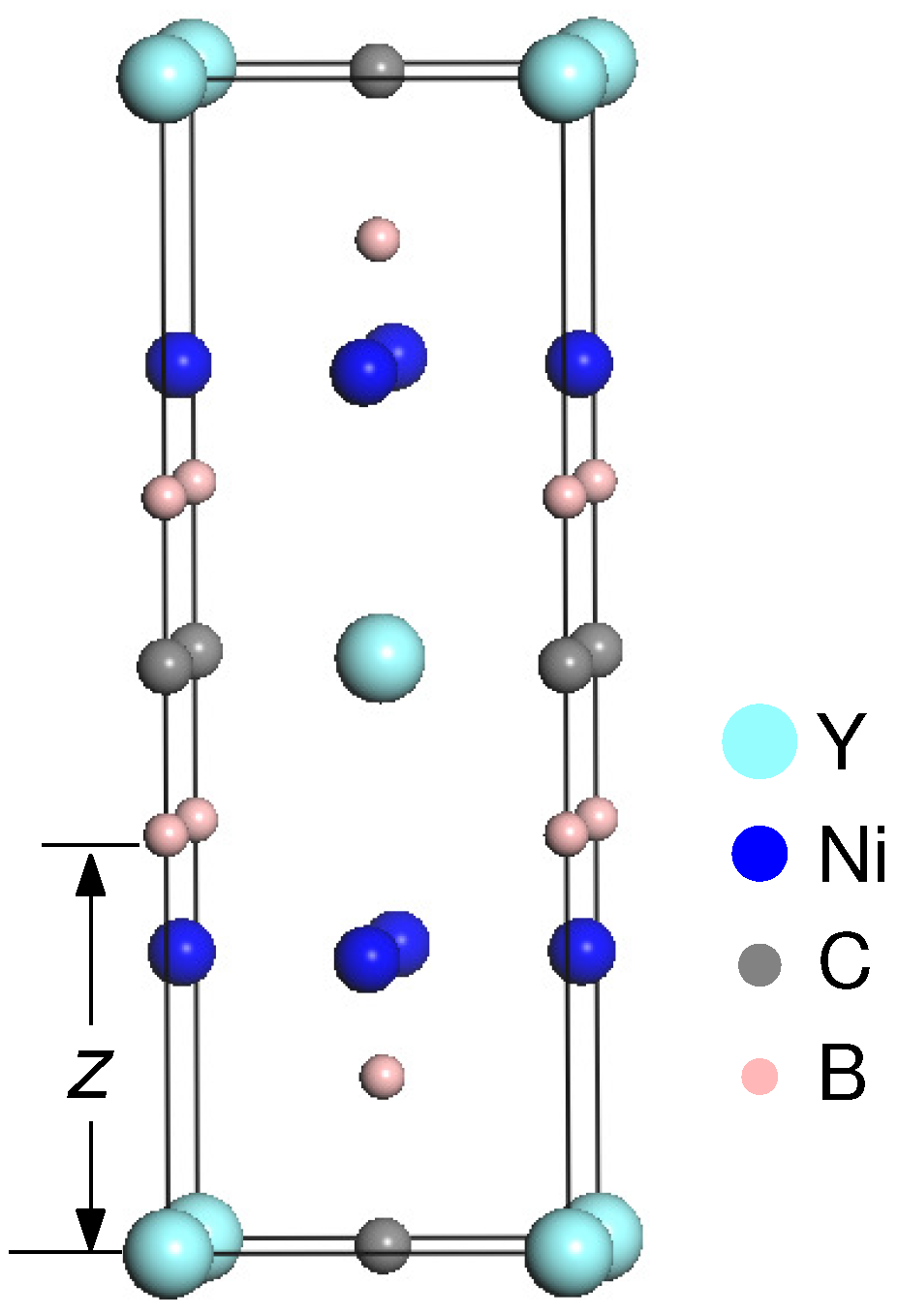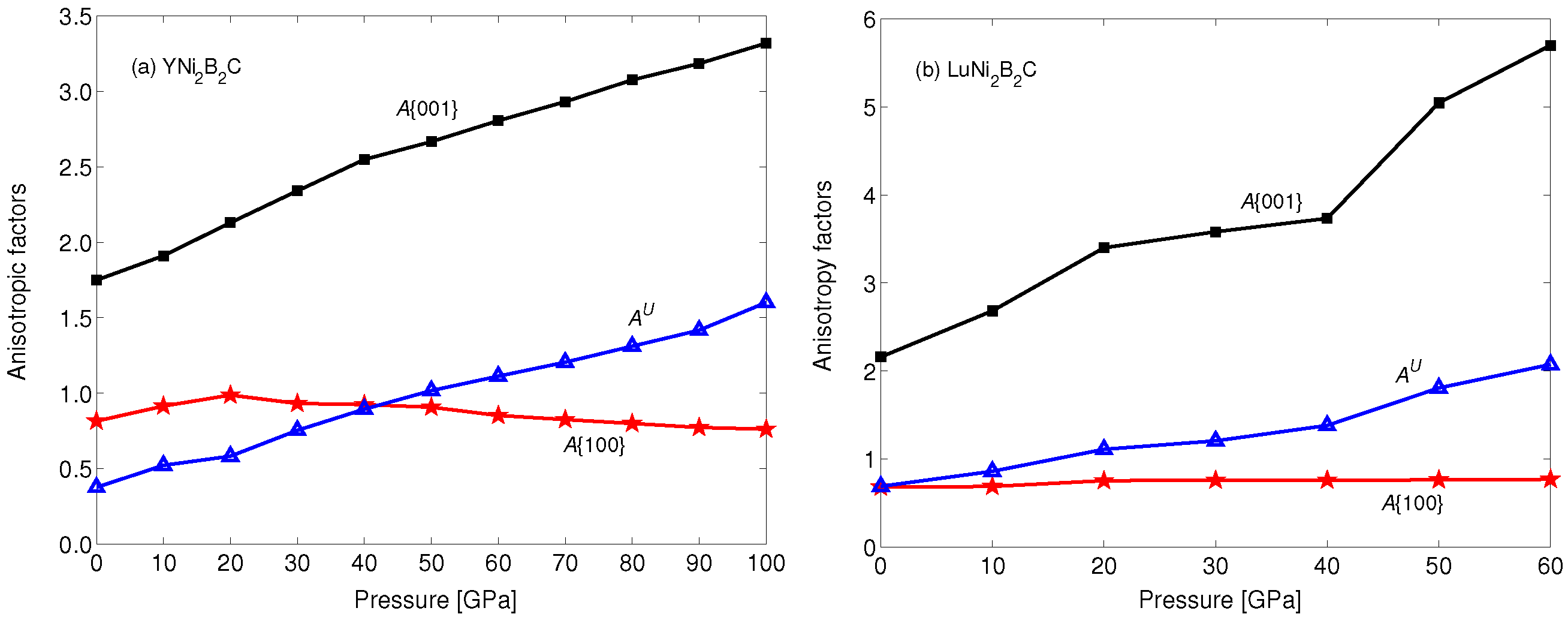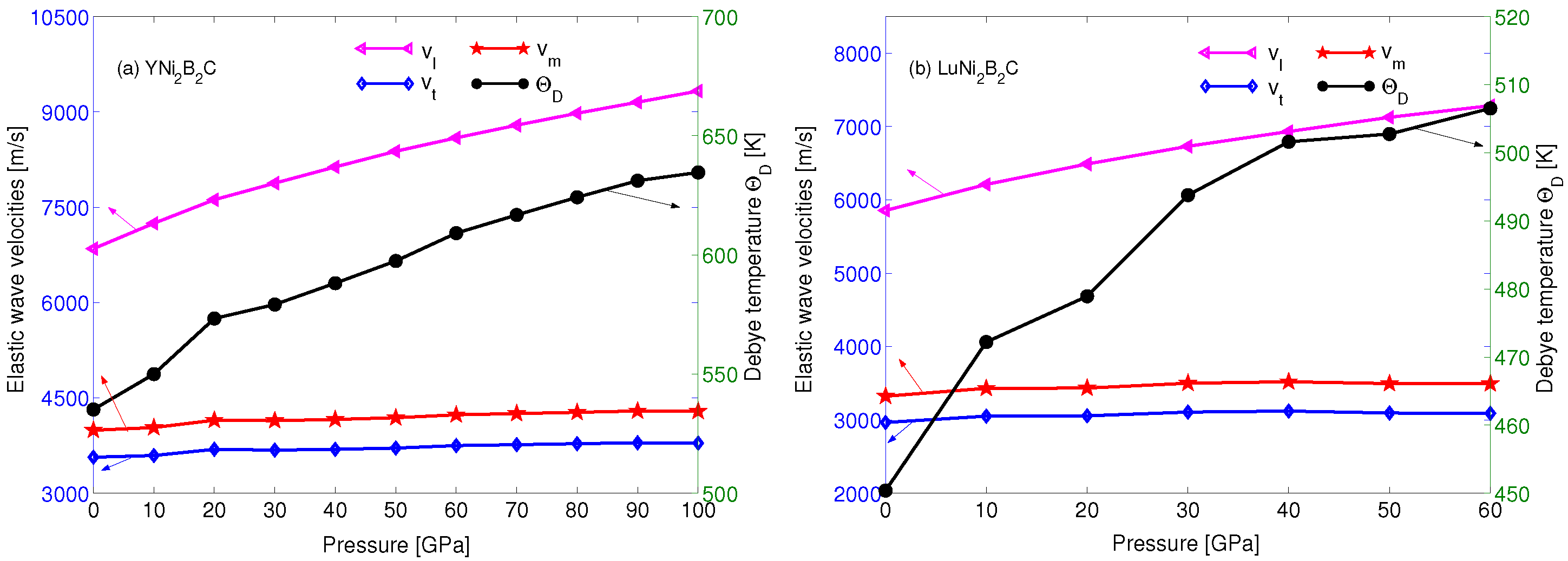First Principles Study on Structure Stability and Mechanical Properties of YNi2B2C and LuNi2B2C under Pressure
Abstract
:1. Introduction
2. Theory and Computational Details
3. Results and Discussion
4. Conclusions
Acknowledgments
Author Contributions
Conflicts of Interest
References
- Mazumdar, C.; Nagarajan, R.; Godart, C.; Gupta, L.C.; Latroche, M.; Dhar, S.K.; Levy-Clement, C.; Padalia, B.D.; Vijayaraghavan, R. Superconductivity at 12 K in Y-Ni-B system. Solid State Commun. 1993, 87, 413–416. [Google Scholar] [CrossRef]
- Nagarajan, R.; Mazumdar, C.; Hossain, Z.; Dhar, S.K.; Gopalakrishnan, K.V.; Gupta, L.C.; Godart, C.; Padalia, B.D.; Vijayaraghavan, R. Bulk superconductivity at an elevated temperature (Tc ≊ 12 K) in a nickel containing alloy system Y-Ni-BC. Phys. Rev. Lett. 1994, 72, 274. [Google Scholar] [CrossRef] [PubMed]
- Cava, R.J.; Takagi, H.; Zandbergen, H.W.; Krajewski, J.J.; Peck, W.F., Jr.; Siegrist, T.; Batlogg, B.; Van Dover, R.B.; Felder, R.J.; Mizuhashi, K.; et al. Superconductivity in the quaternary intermetallic compounds LnNi2B2C. Nature 1994, 367, 252–253. [Google Scholar] [CrossRef]
- Meenakshi, S.; Vijayakumar, V.; Rao, R.S.; Sikka, B.K.; Ravindran, P.; Hossain, Z.; Nagarajan, R.; Gupta, L.C.; Vijayaraghavan, R. High-pressure studies on YNi2B2C at room temperature. Phys. Rev. B 1998, 58, 3377. [Google Scholar] [CrossRef]
- Dervenagas, P.; Bullock, M.; Zarestky, J.; Canfield, P.; Cho, B.K.; Harmon, B.; Goldman, A.I.; Stassis, C. Soft phonons in superconducting LuNi2B2C. Phys. Rev. B 1995, 52, R9839. [Google Scholar] [CrossRef]
- Park, H.-J.; Shin, H.-S.; Lee, H.-G.; Yang, I.-S.; Lee, W.C.; Cho, B.K.; Canfield, P.C.; Johnston, D.C. Raman modes of RNi2B2C (R=Lu, Ho, Y) single crystals. Phys. Rev. B 1996, 53, 2237. [Google Scholar] [CrossRef]
- Meenakshi, S.; Vijayakumar, V.; Rao, R.S.; Godwal, B.K.; Sikka, S.K.; Hossain, Z.; Nagarajan, R.; Gupta, L.C.; Vijayaraghavan, R. High pressure study of borocarbide superconductor YNi2B2C at room temperature. Physica B 1996, 223, 93–95. [Google Scholar] [CrossRef]
- Weber, F.; Rosenkranz, S.; Pintschovius, L.; Castellan, J.-P.; Osborn, R.; Reichardt, W.; Heid, R.; Bohnen, K.-P.; Goremychkin, E.A.; Kreyssig, A.; et al. Electron-phonon coupling in the conventional superconductor YNi2B2C at high phonon energies studied by time-of-flight neutron spectroscopy. Phys. Rev. Lett. 2012, 109, 057001. [Google Scholar] [CrossRef] [PubMed]
- Mattheiss, L.F. Electronic properties of superconducting LuNi2B2C and related boride carbide phases. Phys. Rev. B 1994, 48, 13279. [Google Scholar] [CrossRef]
- Lee, J.I.; Zhao, T.S.; Kim, I.G.; Min, B.I.; Youn, S.J. Electronic structure of Ni-based superconducting quaternary compounds: YNi2B2X (X=B, C, N, and O). Phys. Rev. B 1994, 50, 4030. [Google Scholar] [CrossRef]
- Weht, R.; Cappannini, O.M.; Rodriguez, C.O.; Christensen, N.E. First-principles calculation of compressibilities and their pressure dependence in LuNi2B2C. Physica C 1996, 260, 125. [Google Scholar] [CrossRef]
- Cappannini, O.M.; Rodriguez, C.O.; Christensen, N.E. Pressure dependence of compressibilities in YNi2B2C and YPd2B2C. Physica C 1998, 306, 101. [Google Scholar] [CrossRef]
- Wang, P.; Piao, C.G.; Meng, R.Y.; Cheng, Y.; Ji, G.-F. Elastic and electronic properties of YNi2B2C under pressure from first principles. Physica B 2012, 407, 227–231. [Google Scholar] [CrossRef]
- Tütüncü, H.M.; Uzunok, H.Y.; Karaca, E.; Srivastava, G.P.; Özer, S.; Uğur, S. Ab initio investigation of BCS-type superconductivity in LuNi2B2C-type superconductors. Phys. Rev. B 2015, 92, 054510. [Google Scholar] [CrossRef]
- Kresse, G.; Hafner, J. Ab initio molecular dynamics for open-shell transition metals. Phys. Rev. B 1993, 48, 3115. [Google Scholar] [CrossRef]
- Kresse, G.; Furthmller, J. Efficiency of ab-initio total energy calculations for metals and semiconductors using a plane-wave basis set. Comput. Mater. Sci. 1996, 6, 15–50. [Google Scholar] [CrossRef]
- Kresse, G.; Furthmller, J. Efficient iterative schemes for ab initio total-energy calculations using a plane-wave basis set. Phys. Rev. B 1996, 54, 11169. [Google Scholar] [CrossRef]
- Blöchl, P.E. Projector augmented-wave method. Phys. Rev. B 1994, 50, 17953. [Google Scholar] [CrossRef]
- Kresse, G.; Joubert, D. From ultrasoft pseudopotentials to the projector augmented-wave method. Phys. Rev. B 1999, 59, 1758. [Google Scholar] [CrossRef]
- Perdew, J.P.; Burke, K.; Ernzerhof, M. Generalized gradient approximation made simple. Phys. Rev. Lett. 1996, 77, 3865–3868. [Google Scholar] [CrossRef] [PubMed]
- Monkhorst, H.J.; Pack, J.D. Special points for Brillouin-zone integrations. Phys. Rev. B 1976, 13, 5188. [Google Scholar] [CrossRef]
- Birch, F. Finite Elastic Strain of Cubic Crystals. Phys. Rev. 1947, 71, 809. [Google Scholar] [CrossRef]
- Murnaghan, F. Finite Deformation of an Elastic Solid; Wiley: New York, NY, USA, 1951. [Google Scholar]
- Thurston, R.; Brugger, K. Third-Order Elastic Constants and the Velocity of Small Amplitude Elastic Waves in Homogeneously Stressed Media. Phys. Rev. 1964, 133, A1604. [Google Scholar] [CrossRef]
- Liu, L.L.; Xu, G.; Wang, A.R.; Wu, X.Z.; Wang, R. First-principles investigations on structure stability, elastic properties, anisotropy and Debye temperature of tetragonal LiFeAs and NaFeAs under pressure. J. Phys. Chem. Solids 2017, 104, 243. [Google Scholar] [CrossRef]
- Hill, R. The Elastic Behaviour of a Crystalline Aggregate. Proc. Phys. Soc. A 1953, 65, 349. [Google Scholar] [CrossRef]
- Voigt, W. Lehrbuch der Kristallphysik; Taubner: Leipzig, Germany, 1928. [Google Scholar]
- Reuss, A.; Angew, Z. Calculation of the flow limits of mixed crystals on the basis of the plasticity of monocrystals. Math. Mech. 1929, 9, 49. [Google Scholar]
- Pintschovius, L.; Weber, F.; Reichardt, W.; Kreyssig, A.; Heid, R.; Reznik, D.; Stockert, O.; Hradil, K. Phonon linewidths in YNi2B2C. Pramana-J. Phys. 2008, 71, 687–693. [Google Scholar] [CrossRef]
- Godart, C.; Gupta, L.C.; Nagarajan, R.; Dhar, S.K.; Noel, H.; Potel, M.; Mazumdar, C.; Hossain, Z.; Levy-Clement, C.; Schiffmacher, G.; et al. Structural, superconducting, and magnetic properties of YNi2B2C and ErNi2B2C. Phys. Rev. B 1995, 51, 489. [Google Scholar] [CrossRef]
- Siegrist, T.; Zandbergen, H.W.; Cava, R.J.; Krjcwskl, J.J.; Peck, W.F., Jr. The crystal structure of superconducting LuNl2B2C and the related phase LuNiBC. Nature 1994, 367, 254. [Google Scholar] [CrossRef]
- Belger, A.; Jaenicke-Rössler, U.; Lipp, D.; Wehner, B.; Paufler, P.; Behr, G. Structure refinement of the superconducting phase YNi2B2C as a function of temperature in the range 25–300 K. Physica C 1998, 306, 277. [Google Scholar] [CrossRef]
- Siegrist, T.; Cava, R.J.; Krajewski, J.J.; Peck, W.F., Jr. Crystal chemistry of the series LnT2B2C (Ln = rare earth, T = transition element). J. Alloys Compd. 1994, 216, 135. [Google Scholar] [CrossRef]
- Gao, L.; Qui, X.D.; Cao, Y.; Meng, R.L.; Sun, Y.Y.; Xue, Y.Y.; Chu, C.W. Superconductivity in (LuC)2(Ni2B2) and (LuC)(Ni2B2). Phys. Rev. B 1994, 50, 9445. [Google Scholar] [CrossRef]
- Nohara, M.; Isshiki, M.; Takagi, H.; Cava, R.J. Magnetic Field Dependence of the Low-Temperature Specific Heat of the Borocarbide Superconductor LuNi2B2C. J. Phys. Soc. Jpn. 1997, 66, 1888–1891. [Google Scholar] [CrossRef]
- Narozhnyi, V.N.; Freudenberger, J.; Kochetkov, V.N.; Nenkov, K.A.; Fuchs, G.; Handstein, A.; Müller, K.-H. Hall effect in LuNi2B2C and YNi2B2C borocarbides: A comparative study. Phys. Rev. B 1999, 59, 14762. [Google Scholar] [CrossRef]
- Zarestky, J.; Stassis, C.; Goldman, A.; Canfield, P.; Shirane, G.; Shapiro, S. Phonon profiles in superconducting YNi2B2C and LuNi2B2C. Phys. Rev. B 1999, 60, 11932. [Google Scholar] [CrossRef]
- Zarestky, J.L.; Stassis, C.; Goldman, A.I.; Canfield, P.C.; Shirane, G.; Shapiro, S.M. Phonon–phonon interactions in (Lu, Y)Ni2B2C. J. Phys. Chem. Solids 2002, 63, 811–814. [Google Scholar] [CrossRef]
- Ravindran, P.; Sankaralingam, S.; Asokamani, R. Electronic structure and phase-stability studies on superconducting YNi2B2C, YRh3B, and nonsuperconducting YNi4B. Phys. Rev. B 1995, 52, 12921. [Google Scholar] [CrossRef]
- Rourke, P.M.C.; Paglione, J.; Ronning, F.; Taillefer, L.; Kadowaki, K. Elastic tensor of YNi2B2C. Physica C 2003, 397, 1. [Google Scholar] [CrossRef]
- Mouhat, F.; Coudert, F.X. Necessary and sufficient elastic stability conditions in various crystal systems. Phys. Rev. B 2014, 90, 224104. [Google Scholar] [CrossRef]
- Zhai, H.C.; Li, X.F.; Du, J.Y. First-Principles Calculations on Elasticity and Anisotropy of Tetragonal Tungsten Dinitride under Pressure. Mater. Trans. 2012, 53, 1247–1251. [Google Scholar] [CrossRef]
- Pugh, S.F. XCII. Relations between the elastic moduli and the plastic properties of polycrystalline pure metals. Philos. Mag. 1954, 45, 823–843. [Google Scholar] [CrossRef]
- Brazhkin, V.V.; Lyapin, A.G.; Hemley, R.J. Harder than diamond: Dreams and reality. Philos. Mag. A 2002, 82, 231–253. [Google Scholar] [CrossRef]
- Teter, D.M. Computational alchemy: The search for new superhard materials. MRS Bull. 1998, 23, 22–27. [Google Scholar] [CrossRef]
- Chen, X.Q.; Niu, H.Y.; Li, D.Z.; Li, Y.Y. Modeling hardness of polycrystalline materials and bulk metallic glasses. Intermetallics 2011, 19, 1275–1281. [Google Scholar] [CrossRef]
- Chen, X.Q.; Niu, H.Y.; Franchini, C.; Li, D.Z.; Li, Y.Y. Hardness of T-carbon: Density functional theory calculations. Phys. Rev. B 2011, 84, 121405(R). [Google Scholar] [CrossRef]
- Ravindran, P.; Fast, L.; Korzhayi, P.A.; Johansson, B. Density functional theory for calculation of elastic properties of orthorhombic crystals: Application to TiSi2. J. Appl. Phys. 1998, 84, 4891–4904. [Google Scholar] [CrossRef]
- Ranganathan, S.I.; Ostoja-Starzewski, M. Universal Elastic Anisotropy Index. Phys. Rev. Lett. 2008, 101, 055504. [Google Scholar] [CrossRef] [PubMed]
- Anderson, O.L. A simplified method for calculating the debye temperature from elastic constants. J. Phys. Chem. Solids 1963, 24, 909–917. [Google Scholar] [CrossRef]
- Schreiber, E.; Anderson, O.L.; Soga, N. Elastic Constants and Their Measurements; McGraw: New York, NY, USA, 1973. [Google Scholar]
- Hong, N.M.; Michor, H.; Vybornov, M.; Holubar, T.; Hundegger, P.; Perthold, W.; Hilscher, G.; Rogl, P. Superconductivity in Y-Ni-B base compounds. Physica C 1994, 227, 85–94. [Google Scholar] [CrossRef]
- Carter, S.A.; Batlogg, B.; Cava, R.J.; Krajewski, J.J.; Peck, W.F., Jr.; Takagi, H. Electron density of states in the borocarbide intermetallic superconductors. Phys. Rev. B 1994, 50, 4216. [Google Scholar] [CrossRef]







| Material | Method | a/Å | c/Å | c/a | z |
|---|---|---|---|---|---|
| YNiBC | Present GGA | 3.553 | 10.400 | 2.927 | 0.356 |
| GGA [13] | 3.541 | 10.482 | 2.960 | 0.358 | |
| LMTO [39] | 3.507 | 10.485 | 2.937 | 0.353 | |
| Experimental [29] | 3.526 | 10.543 | 2.990 | 0.358 | |
| Experimental [30] | 3.524 | 10.545 | 2.992 | 0.375 | |
| Experimental [31] | 3.5258 | 10.5425 | 2.990 | ||
| Experimental [32] | 3.51 | 10.53 | 3.0 | ||
| LuNiBC | Present GGA | 3.473 | 10.552 | 3.038 | 0.359 |
| GGA [14] | 3.508 | 10.597 | 3.021 | 0.360 | |
| LDA [11] | 3.457 | 9.989 | 2.889 | ||
| Experimental [33] | 3.464 | 10.631 | 3.069 | 0.362 | |
| Experimental [34] | 3.467 | 10.633 | 3.067 | ||
| Experimental [35] | 3.464 | 10.623 | 3.067 | ||
| Experimental [36] | 3.464 | 10.635 | 3.070 | ||
| Experimental [37] | 3.464 | 10.623 | 3.067 | ||
| Experimental [38] | 3.464 | 10.631 | 3.069 |
| Material | Pressure | ||||||
|---|---|---|---|---|---|---|---|
| YNiBC | 0 | 281.7 | 135.4 | 130.3 | 279.9 | 61.4 | 127.9 |
| 292.7 , 294.6 | 133.6 , 157.7 | 138.6 | 282.4 | 68.6 , 64.4 | 129.8 , 142.1 | ||
| 284.7 , 292 | 145.7 , 149.8 | 125.6 | 261.5 | 67.1 , 67.4 | 143.3 , 132 | ||
| 10 | 332.6 | 174.4 | 175.9 | 308.3 | 66.0 | 151.1 | |
| 20 | 378.2, 381.3 | 215.8, 211.3 | 212.2, 211.2 | 348.8, 362.6 | 74.7, 72.8 | 172.9, 174.9 | |
| 30 | 420.5 | 255.9 | 247.7 | 388.4 | 73.0 | 192.6 | |
| 40 | 461.2, 462.2 | 294.7, 298.9 | 283.4, 281.5 | 427.1, 427.0 | 74.3, 75.9 | 212.2, 211.8 | |
| 50 | 503.9 | 331.1 | 319.7 | 467.1 | 75.2 | 230.5 | |
| 60 | 544.8, 534.6 | 367.7, 373.3 | 347.1, 338.7 | 507.1, 519.5 | 76.3, 80.3 | 248.4, 245.8 | |
| 70 | 584.4 | 404.6 | 378.8 | 546.3 | 76.9 | 263.4 | |
| 80 | 622.6, 617.8 | 440.9, 449.4 | 409.7, 404.0 | 584.8, 609.3 | 77.6, 84.8 | 279.4, 279.4 | |
| 90 | 661.3 | 475.9 | 440.2 | 622.1 | 77.9 | 295.0 | |
| 100 | 699.7, 690.0 | 510.3, 529.6 | 477.5, 470.0 | 658.2, 683.1 | 76.7, 87.1 | 314.4, 311.7 | |
| LuNiBC | 0 | 287.9 | 157.1 | 134.9 | 297.8 | 53.8 | 141.4 |
| 10 | 330.3 | 204.5 | 167.7 | 356.6 | 60.5 | 168.9 | |
| 20 | 367.9 | 253.4 | 210.8 | 394.2 | 64.2 | 194.7 | |
| 30 | 411.2 | 290.5 | 242.0 | 432.8 | 68.4 | 216.3 | |
| 40 | 455.7 | 328.7 | 273.3 | 466.0 | 67.9 | 237.0 | |
| 50 | 484.1 | 381.2 | 310.4 | 511.2 | 71.4 | 259.6 | |
| 60 | 519.7 | 421.9 | 341.9 | 542.3 | 72.8 | 278.9 |
| Material | Pressure | |||||
|---|---|---|---|---|---|---|
| YNiBC | 0 | 6.069 | 6847.77 | 3566.17 | 3990.44 | 535.15 |
| 10 | 6.377 | 7246.30 | 3594.23 | 4033.93 | 549.98 | |
| 20 | 6.643 | 7617.45 | 3691.12 | 4148.07 | 573.32 | |
| 30 | 6.883 | 7878.95 | 3678.01 | 4141.22 | 579.19 | |
| 40 | 7.102 | 8134.20 | 3691.23 | 4161.57 | 588.14 | |
| 50 | 7.305 | 8381.16 | 3710.74 | 4188.02 | 597.45 | |
| 60 | 7.494 | 8591.38 | 3749.03 | 4233.73 | 609.13 | |
| 70 | 7.671 | 8791.34 | 3763.58 | 4253.32 | 616.75 | |
| 80 | 7.839 | 8977.65 | 3779.16 | 4273.58 | 624.16 | |
| 90 | 7.998 | 9152.06 | 3793.77 | 4294.42 | 631.14 | |
| 100 | 8.151 | 9327.74 | 3788.02 | 4288.85 | 634.60 | |
| LuNiBC | 0 | 8.505 | 5855.49 | 2965.24 | 3323.92 | 450.39 |
| 10 | 8.917 | 6210.38 | 3050.63 | 3430.36 | 472.20 | |
| 20 | 9.277 | 6489.19 | 3055.01 | 3433.64 | 478.92 | |
| 30 | 9.602 | 6730.18 | 3106.51 | 3499.64 | 493.77 | |
| 40 | 9.898 | 6932.53 | 3120.50 | 3519.38 | 501.61 | |
| 50 | 10.175 | 7125.55 | 3094.35 | 3495.08 | 502.75 | |
| 60 | 10.432 | 7285.06 | 3088.95 | 3492.15 | 506.51 |
© 2017 by the authors. Licensee MDPI, Basel, Switzerland. This article is an open access article distributed under the terms and conditions of the Creative Commons Attribution (CC BY) license (http://creativecommons.org/licenses/by/4.0/).
Share and Cite
Liu, L.; Wu, X.; Wang, R.; Hu, Z.; Jiang, Y.; Liu, D. First Principles Study on Structure Stability and Mechanical Properties of YNi2B2C and LuNi2B2C under Pressure. Crystals 2017, 7, 173. https://doi.org/10.3390/cryst7060173
Liu L, Wu X, Wang R, Hu Z, Jiang Y, Liu D. First Principles Study on Structure Stability and Mechanical Properties of YNi2B2C and LuNi2B2C under Pressure. Crystals. 2017; 7(6):173. https://doi.org/10.3390/cryst7060173
Chicago/Turabian StyleLiu, Lili, Xiaozhi Wu, Rui Wang, Zhengquan Hu, Youchang Jiang, and Dingxing Liu. 2017. "First Principles Study on Structure Stability and Mechanical Properties of YNi2B2C and LuNi2B2C under Pressure" Crystals 7, no. 6: 173. https://doi.org/10.3390/cryst7060173





